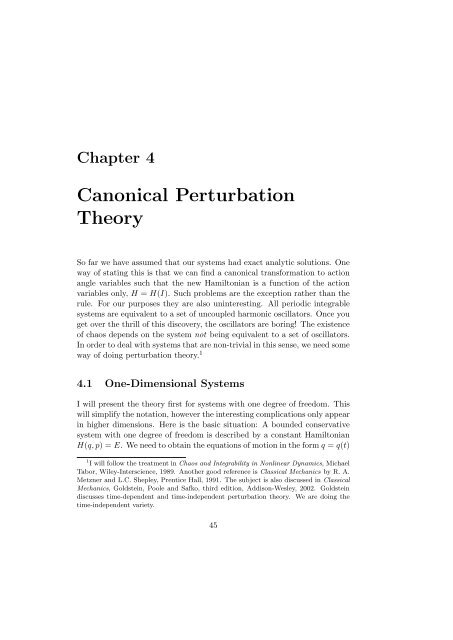Nonlinear Mechanics - Physics at Oregon State University
Nonlinear Mechanics - Physics at Oregon State University
Nonlinear Mechanics - Physics at Oregon State University
You also want an ePaper? Increase the reach of your titles
YUMPU automatically turns print PDFs into web optimized ePapers that Google loves.
Chapter 4<br />
Canonical Perturb<strong>at</strong>ion<br />
Theory<br />
So far we have assumed th<strong>at</strong> our systems had exact analytic solutions. One<br />
way of st<strong>at</strong>ing this is th<strong>at</strong> we can find a canonical transform<strong>at</strong>ion to action<br />
angle variables such th<strong>at</strong> the new Hamiltonian is a function of the action<br />
variables only, H = H(I). Such problems are the exception r<strong>at</strong>her than the<br />
rule. For our purposes they are also uninteresting. All periodic integrable<br />
systems are equivalent to a set of uncoupled harmonic oscill<strong>at</strong>ors. Once you<br />
get over the thrill of this discovery, the oscill<strong>at</strong>ors are boring! The existence<br />
of chaos depends on the system not being equivalent to a set of oscill<strong>at</strong>ors.<br />
In order to deal with systems th<strong>at</strong> are non-trivial in this sense, we need some<br />
way of doing perturb<strong>at</strong>ion theory. 1<br />
4.1 One-Dimensional Systems<br />
I will present the theory first for systems with one degree of freedom. This<br />
will simplify the not<strong>at</strong>ion, however the interesting complic<strong>at</strong>ions only appear<br />
in higher dimensions. Here is the basic situ<strong>at</strong>ion: A bounded conserv<strong>at</strong>ive<br />
system with one degree of freedom is described by a constant Hamiltonian<br />
H(q, p) = E. We need to obtain the equ<strong>at</strong>ions of motion in the form q = q(t)<br />
1 I will follow the tre<strong>at</strong>ment in Chaos and Integrability in <strong>Nonlinear</strong> Dynamics, Michael<br />
Tabor, Wiley-Interscience, 1989. Another good reference is Classical <strong>Mechanics</strong> by R. A.<br />
Metzner and L.C. Shepley, Prentice Hall, 1991. The subject is also discussed in Classical<br />
<strong>Mechanics</strong>, Goldstein, Poole and Safko, third edition, Addison-Wesley, 2002. Goldstein<br />
discusses time-dependent and time-independent perturb<strong>at</strong>ion theory. We are doing the<br />
time-independent variety.<br />
45
















